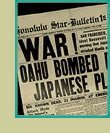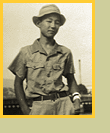
 |

The bombing of Pearl Harbor on December 7, 1941, is a shock to Mitsuo and his family. What about Father? There's no way to find out if he's been hurt or killed. Two years after the United States and Japan declare war, the family finally receives a letter telling them he's alive. In their first months in Japan before Pearl Harbor, Mitsuo's father sent the family money. Now with the war on, Mrs. Tomosawa must support her sons. She gets a job as a clerk in an office in Hiroshima. Mitsuo is a U.S. citizen, and Japan and America are at war. He feels upset by the conflict, as though two parents were fighting — his native country, America, and his adopted country, Japan. Yet, the Japanese children at school don't treat him any differently. It's his Korean classmates who call him "Yank" — and worse. The Koreans are often harassed by the Japanese. Unfortunately for Mitsuo, now the Korean kids have someone to pick on, too. |

Life gets harder and harder as 1942 turns into 1943. Everything is rationed — food, clothing, fuel. Each person is allowed one egg per year. The family's paper and wood house is freezing in the winter. The charcoal ration is only enough for a fire to warm their hands. Mitsuo's school closed down. All students are assigned jobs to help in the war effort. Mitsuo works in a warehouse containing Japanese military uniforms. He spends every day loading and unloading bundles. Each morning, Mitsuo's supervisor gives the workers a patriotic pep talk. But by 1945, everyone knows the war is going badly for Japan. There is no food. The family is eating soup made from grass. American B-29 bombers fly unchecked in the skies. Mitsuo sees them again and again, headed for Tokyo and Osaka. Surprisingly, Hiroshima is never bombed. As time goes on, people begin ignoring the American war planes and the air-raid sirens. They grow tired of the false alarms, and go about their business. Why do you think the Korean kids are cruel to Mitsuo? Why do people who are picked on sometimes look for somebody to pick on, too? Meet other young Japanese Americans who lived in Japan during World War II. |